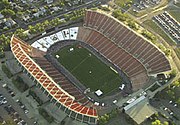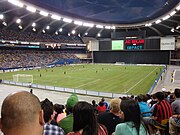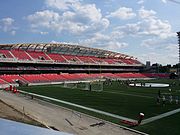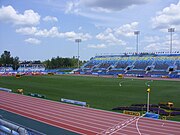2015 FIFA Women's World Cup
| Coupe du monde féminine de la FIFA 2015 | |
|---|---|
 | |
| Tournament details | |
| Host country | Canada |
| Dates | 6 June – 5 July |
| Teams | 24 (from 6 confederations) |
| Venue(s) | 6 (in 6 host cities) |
| Final positions | |
| Champions | |
| Runners-up | |
| Third place | |
| Fourth place | |
| Tournament statistics | |
| Matches played | 52 |
| Goals scored | 146 (2.81 per match) |
| Attendance | 1,353,506 (26,029 per match) |
| Top scorer(s) | (6 goals each) |
| Best player(s) | |
| Best young player | |
| Best goalkeeper | |
| Fair play award | |
← 2011 2019 → | |
The 2015 FIFA Women's World Cup was the seventh FIFA Women's World Cup, the quadrennial international soccer championship contested by the women's national teams of the member associations of FIFA. The tournament was hosted by Canada for the first time and by a North American country for the third time. Matches were played in six cities across Canada in five time zones. The tournament began on 6 June 2015, and finished with the final on 5 July 2015[1] with a United States victory over Japan.
The 2015 tournament saw the World Cup expanded to 24 teams from 16 in 2011.[2] Canada's team received direct entry as host and a qualification tournament of 134 teams was held for the remaining 23 places. With the expanded tournament, eight teams made their Women's World Cup debut.[2] All previous Women's World Cup finalists qualified for the tournament, with defending champions Japan and returning champions Germany (2003, 2007) and the United States (1991, 1999) among the seeded teams.[3]
The 2015 tournament used goal-line technology for the first time with the Hawk-Eye system. It was also the first World Cup for either men or women to be played on artificial turf, with all matches played on such surfaces, even though there were some initial concerns over a possible increased risk of injuries.
Host selection
[edit]The bidding for each FIFA Women's World Cup typically includes hosting rights for the previous year's FIFA U-20 Women's World Cup (similar to the men's version, in which the host nation stages the Confederations Cup the year before). Bids for the tournament were required to be submitted by December 2010. Only two bids were submitted:[4]
| Country |
|---|
Zimbabwe withdrew its bid on 1 March 2011.[6] The country was seen as a long shot as its women's team was ranked 103rd in the world at the time of the bid and has never qualified for a Women's World Cup. There was also ongoing political and economic instability in the country.[7]
The selected host, Canada, had previously hosted FIFA tournaments including the 1987 FIFA U-16 World Championship, 2002 FIFA U-19 Women's World Championship, the 2007 FIFA U-20 World Cup, which set an attendance record for that tournament, and most recently the 2014 FIFA U-20 Women's World Cup.
Qualification
[edit]For 2015, the number of qualifying teams grew from 16 to 24 and scheduled matches increased from 32 to 52.[8] On 11 June 2012, FIFA announced a change to the allocation of the qualifying berths for its continental confederations. The FIFA Executive Committee approved the following slot allocation and the distribution of eight new slots:[9]
| Confederation/hosts | Continent/country | Slots | Change from 2011 |
|---|---|---|---|
| AFC | Asia | 5 | +2 |
| CAF | Africa | 3 | +1 |
| CONCACAF | North, Central America and Caribbean | 3.5 | +1 |
| CONMEBOL | South America | 2.5 | +0.5 |
| OFC | Oceania | 1 | ±0 |
| UEFA | Europe | 8 | +3.5 |
| Hosts | Canada | 1 | – |
| Total | 24 | +8 | |
After North Korea had several players test positive for performance-enhancing drugs during the 2011 FIFA Women's World Cup, FIFA banned the North Korean team from participating in the 2015 FIFA Women's World Cup in Canada. This was the first time a team had been banned from a Women's World Cup, and it was the first time since 1995 that North Korea did not participate in a Women's World Cup.[10]
Qualified teams
[edit]The latest published FIFA Rankings prior to the tournament (March 2015) are shown in parentheses.[11]
|
|
|
|
A then-record eight nations made their Women's World Cup debut, as listed above: Cameroon, Costa Rica, Ecuador, Ivory Coast, Netherlands, Spain, Switzerland, and Thailand. As of 2023, this is the last time Ecuador, Ivory Coast, and Mexico have qualified.
Venues
[edit]The cities of Vancouver, Edmonton, Winnipeg, Ottawa, Montreal and Moncton were selected to host tournament matches.[12] Halifax was also considered, but removed itself from contention in March 2012.[13] Toronto decided not to bid, due to potential conflicts with the 2015 Pan American Games.[14] Due to FIFA's policy against commercial sponsorship of stadium names, Investors Group Field in Winnipeg and TD Place Stadium in Ottawa were respectively known as Winnipeg Stadium[15] and Lansdowne Stadium[16] during the tournament. Seating capacities shown in table below are as configured for these FIFA games.
| Edmonton | Montreal | Vancouver | Winnipeg |
|---|---|---|---|
| Commonwealth Stadium | Olympic Stadium | BC Place | Investors Group Field (Winnipeg Stadium) |
| 53°33′35″N 113°28′34″W / 53.55972°N 113.47611°W | 45°33′28″N 73°33′7″W / 45.55778°N 73.55194°W | 49°16′36″N 123°6′43″W / 49.27667°N 123.11194°W | 49°48′28″N 97°8′45″W / 49.80778°N 97.14583°W |
| Capacity: 56,302 | Capacity: 56,040 | Capacity: 54,320 | Capacity: 33,422 |
| Surface: FieldTurf Duraspine | Surface: Xtreme Turf | Surface: Polytan LigaTurf | Surface: FieldTurf Revolution |
| Time zone: MDT (UTC−6) | Time zone: EDT (UTC−4) | Time zone: PDT (UTC−7) | Time zone: CDT (UTC−5) |
 |  |  |  |
| Ottawa | Moncton | ||
| TD Place Stadium (Lansdowne Stadium) | Moncton Stadium | ||
| 45°23′53.44″N 75°41′1.14″W / 45.3981778°N 75.6836500°W | 46°6′30″N 64°47′0″W / 46.10833°N 64.78333°W | ||
| Capacity: 24,000 | Capacity: 13,000 | ||
| Surface: FieldTurf | Surface: FieldTurf | ||
| Time zone: EDT (UTC−4) | Time zone: ADT (UTC−3) | ||
 |  | ||
Innovations
[edit]The tournament introduced goal-line technology with the Hawk-Eye system by which it is possible to show on the stadium screen if the ball was in or not.[17][18] It was also the first World Cup for either men or women to be played on artificial turf,[clarification needed] with all matches played on such surfaces. There were some initial concerns (please see below) over a possible increased risk of injuries from playing on artificial turf, but a legal challenge suggesting matches should be played on grass as in similar men's tournaments was dropped in January 2015.[19]
Squads
[edit]Each team's squad for the 2015 FIFA Women's World Cup consisted of 23 players (three of whom must be goalkeepers), two more than the 2011 tournament, and the same number as men's World Cup squads. Each participating national association was required to confirm its final 23-player squad no later than 10 working days before the start of the tournament. Replacement of seriously injured players was permitted until 24 hours before the team in question's first World Cup game.[20]
The squads were officially announced by FIFA on 28 May 2015.[21][22] Formiga of Brazil and Homare Sawa of Japan were included in World Cup squads for the sixth time, a record for any men or women players.[23]
Match officials
[edit]A total of 29 referees/support referees and 44 assistant referees were selected for the tournament.[24][25]
Draw
[edit]The draw was held on 6 December 2014 at 12:00 Eastern Standard Time at the Canadian Museum of Nature in Ottawa, Ontario, Canada.[26] The seeding pots were announced the day before. Because UEFA qualified eight teams into the final tournament, which had only six groups, two groups by necessity had to contain two European teams. Otherwise, no group could have more than one team from any confederation.[27] Despite having a lower FIFA ranking than Sweden and England, Brazil was seeded ahead of both for "geographical reasons".[28][29][30] Before the draw, the Organizing Committee placed the seeded teams in the following groups: Germany in Group B, Japan in Group C, United States in Group D, Brazil in Group E, and France in Group F; Canada were already in Group A as the tournament host.[31] Not drawing the groups for the seeded teams has drawn some criticism.[32][33][34] A FIFA spokesperson later confirmed that teams were allocated to certain groups for promotional reasons.[35]
The group of death for this FIFA World Cup was Group D with three top 10-ranked teams, USA (2), Sweden (5) and Australia (10).[36]
| The four draw pots of the tournament | |||
|---|---|---|---|
| Pot 1 (Seeds) | Pot 2 (CAF, CONCACAF, OFC) | Pot 3 (AFC, CONMEBOL) | Pot 4 (UEFA) |
Group stage
[edit]The 24 teams of the tournament were arranged into 6 groups labelled A to F. The provisional match schedule for the tournament was released on 21 March 2013,[37] with the hosts, Canada, placed in position A1. The final schedule with match times was released on the same day right after the draw was made.[38]
The first round, or group stage, saw the twenty four teams divided into six groups of four teams. Each group was played in a round-robin-format of six games, where each team played one match against each of the other teams in the same group. Teams were awarded three points for a win, one point for a draw and none for a defeat. The winners and runners-up from each group, as well as the best four third-placed teams, qualified for the first round of the knockout stage.[20]
| Tie-breaking criteria for group play |
|---|
The ranking of teams in the group stage was determined as follows:[20]
|
Group A
[edit]| Pos | Team | Pld | W | D | L | GF | GA | GD | Pts | Qualification |
|---|---|---|---|---|---|---|---|---|---|---|
| 1 | 3 | 1 | 2 | 0 | 2 | 1 | +1 | 5 | Advance to knockout stage | |
| 2 | 3 | 1 | 1 | 1 | 3 | 3 | 0 | 4 | ||
| 3 | 3 | 1 | 1 | 1 | 2 | 2 | 0 | 4 | ||
| 4 | 3 | 0 | 2 | 1 | 2 | 3 | −1 | 2 |
| China | 1–0 | |
|---|---|---|
| Report |
| Netherlands | 1–1 | |
|---|---|---|
| Report |
|
| China | 2–2 | |
|---|---|---|
| Report |
Group B
[edit]| Pos | Team | Pld | W | D | L | GF | GA | GD | Pts | Qualification |
|---|---|---|---|---|---|---|---|---|---|---|
| 1 | 3 | 2 | 1 | 0 | 15 | 1 | +14 | 7 | Advance to knockout stage | |
| 2 | 3 | 2 | 1 | 0 | 8 | 2 | +6 | 7 | ||
| 3 | 3 | 1 | 0 | 2 | 3 | 10 | −7 | 3 | ||
| 4 | 3 | 0 | 0 | 3 | 3 | 16 | −13 | 0 |
| Ivory Coast | 1–3 | |
|---|---|---|
| Report |
|
Group C
[edit]| Pos | Team | Pld | W | D | L | GF | GA | GD | Pts | Qualification |
|---|---|---|---|---|---|---|---|---|---|---|
| 1 | 3 | 3 | 0 | 0 | 4 | 1 | +3 | 9 | Advance to knockout stage | |
| 2 | 3 | 2 | 0 | 1 | 9 | 3 | +6 | 6 | ||
| 3 | 3 | 1 | 0 | 2 | 11 | 4 | +7 | 3 | ||
| 4 | 3 | 0 | 0 | 3 | 1 | 17 | −16 | 0 |
| Cameroon | 6–0 | |
|---|---|---|
| Report |
| Switzerland | 1–2 | |
|---|---|---|
| Report |
|
Group D
[edit]| Pos | Team | Pld | W | D | L | GF | GA | GD | Pts | Qualification |
|---|---|---|---|---|---|---|---|---|---|---|
| 1 | 3 | 2 | 1 | 0 | 4 | 1 | +3 | 7 | Advance to knockout stage | |
| 2 | 3 | 1 | 1 | 1 | 4 | 4 | 0 | 4 | ||
| 3 | 3 | 0 | 3 | 0 | 4 | 4 | 0 | 3 | ||
| 4 | 3 | 0 | 1 | 2 | 3 | 6 | −3 | 1 |
Group E
[edit]| Pos | Team | Pld | W | D | L | GF | GA | GD | Pts | Qualification |
|---|---|---|---|---|---|---|---|---|---|---|
| 1 | 3 | 3 | 0 | 0 | 4 | 0 | +4 | 9 | Advance to knockout stage | |
| 2 | 3 | 1 | 1 | 1 | 4 | 5 | −1 | 4 | ||
| 3 | 3 | 0 | 2 | 1 | 3 | 4 | −1 | 2 | ||
| 4 | 3 | 0 | 1 | 2 | 2 | 4 | −2 | 1 |
| Spain | 1–1 | |
|---|---|---|
| Report |
|
| South Korea | 2–2 | |
|---|---|---|
| Report |
|
| Costa Rica | 0–1 | |
|---|---|---|
| Report |
|
| South Korea | 2–1 | |
|---|---|---|
| Report |
|
Group F
[edit]| Pos | Team | Pld | W | D | L | GF | GA | GD | Pts | Qualification |
|---|---|---|---|---|---|---|---|---|---|---|
| 1 | 3 | 2 | 0 | 1 | 6 | 2 | +4 | 6 | Advance to knockout stage | |
| 2 | 3 | 2 | 0 | 1 | 4 | 3 | +1 | 6 | ||
| 3 | 3 | 1 | 1 | 1 | 4 | 3 | +1 | 4 | ||
| 4 | 3 | 0 | 1 | 2 | 2 | 8 | −6 | 1 |
Ranking of third-placed teams
[edit]The four best third-placed teams from the six groups advanced to the knockout stage along with the six group winners and six runners-up.[20]
| Pos | Grp | Team | Pld | W | D | L | GF | GA | GD | Pts | Qualification |
|---|---|---|---|---|---|---|---|---|---|---|---|
| 1 | F | 3 | 1 | 1 | 1 | 4 | 3 | +1 | 4 | Advance to knockout stage | |
| 2 | A | 3 | 1 | 1 | 1 | 2 | 2 | 0 | 4 | ||
| 3 | C | 3 | 1 | 0 | 2 | 11 | 4 | +7 | 3 | ||
| 4 | D | 3 | 0 | 3 | 0 | 4 | 4 | 0 | 3 | ||
| 5 | B | 3 | 1 | 0 | 2 | 3 | 10 | −7 | 3 | ||
| 6 | E | 3 | 0 | 2 | 1 | 3 | 4 | −1 | 2 |
Rules for classification: 1) Points; 2) Goal difference; 3) Goals scored; 4) Drawing of lots.
Knockout stage
[edit]The knockout stage comprised the 16 teams that advanced from the group stage of the tournament. There were four rounds of matches, with each round eliminating half of the teams entering that round. The successive rounds were the round of 16, quarter-finals, semi-finals, and the final. There was also a match to decide third and fourth place. For each game in the knockout stage, any draw at 90 minutes was followed by 30 minutes of extra time; if scores were still level, there was a penalty shootout to determine who progressed to the next round.[20] Single yellow cards accrued were cancelled after the quarter-finals, therefore ensuring that no players miss the Final because of receiving a caution in the semi-finals.[75]
Three spots in the 2016 Summer Olympics women's football tournament were filled by the UEFA teams that progressed the furthest in the tournament, other than England.[76][77][n 1] Two spots went to France and Germany which both reached the quarter-finals.[81] The third spot was a tie between four teams eliminated in the round of 16: Netherlands, Norway, Sweden and Switzerland. A play-off tournament in March 2016 determined UEFA's third Olympic qualifier to be Sweden.[82][83]
Bracket
[edit]| Round of 16 | Quarter-finals | Semi-finals | Final | |||||||||||
| 20 June – Edmonton | ||||||||||||||
| 1 | ||||||||||||||
| 26 June – Ottawa | ||||||||||||||
| 0 | ||||||||||||||
| 0 | ||||||||||||||
| 22 June – Edmonton | ||||||||||||||
| 1 | ||||||||||||||
| 2 | ||||||||||||||
| 30 June – Montreal | ||||||||||||||
| 0 | ||||||||||||||
| 2 | ||||||||||||||
| 20 June – Ottawa | ||||||||||||||
| 0 | ||||||||||||||
| 4 | ||||||||||||||
| 26 June – Montreal | ||||||||||||||
| 1 | ||||||||||||||
| 1 (5) | ||||||||||||||
| 21 June – Montreal | ||||||||||||||
| 1 (4) | ||||||||||||||
| 3 | ||||||||||||||
| 5 July – Vancouver | ||||||||||||||
| 0 | ||||||||||||||
| 5 | ||||||||||||||
| 21 June – Moncton | ||||||||||||||
| 2 | ||||||||||||||
| 0 | ||||||||||||||
| 27 June – Edmonton | ||||||||||||||
| 1 | ||||||||||||||
| 0 | ||||||||||||||
| 23 June – Vancouver | ||||||||||||||
| 1 | ||||||||||||||
| 2 | ||||||||||||||
| 1 July – Edmonton | ||||||||||||||
| 1 | ||||||||||||||
| 2 | ||||||||||||||
| 22 June – Ottawa | ||||||||||||||
| 1 | Third place play-off | |||||||||||||
| 1 | ||||||||||||||
| 27 June – Vancouver | 4 July – Edmonton | |||||||||||||
| 2 | ||||||||||||||
| 2 | 0 | |||||||||||||
| 21 June – Vancouver | ||||||||||||||
| 1 | 1 | |||||||||||||
| 1 | ||||||||||||||
| 0 | ||||||||||||||
Round of 16
[edit]| Japan | 2–1 | |
|---|---|---|
| Report |
|
Quarter-finals
[edit]| China | 0–1 | |
|---|---|---|
| Report |
|
Semi-finals
[edit]Third place play-off
[edit]Final
[edit]Awards
[edit]The following awards were given at the conclusion of the tournament.[100] The Golden Ball (best overall player), Golden Boot (top scorer) and Golden Glove (best goalkeeper) awards were sponsored by Adidas, while the Best Young Player and Goal of the Tournament awards were sponsored by Hyundai Motor Company.[101] FIFA.com shortlisted twelve goals for users to vote on as the tournaments' best,[102] with the poll closing on 13 July 2015.[103]
| Golden Ball | Silver Ball | Bronze Ball |
|---|---|---|
| Golden Boot | Silver Boot | Bronze Boot |
| 6 goals, 1 assist 553 minutes played | 6 goals, 1 assist 630 minutes played | 5 goals, 2 assists 474 minutes played |
| Golden Glove | ||
| Best Young Player | ||
| Goal of the Tournament | ||
| FIFA Fair Play Award | ||
On 2 July 2015, following the semi-finals, FIFA announced the shortlists for three of the tournament awards.[104][105] The following candidates were ultimately not selected:
- Golden Ball: Saori Ariyoshi (Japan), Lucy Bronze (England), Julie Johnston (United States), Megan Rapinoe (United States), Célia Šašić (Germany)
- Golden Glove: Nadine Angerer (Germany), Ayumi Kaihori (Japan)
- Best Young Player: Ada Hegerberg (Norway), Tang Jiali (China PR)
All-Star Squad
[edit]The All-Star Squad elected by FIFA's Technical Study Group consists of the following players:[


 French
French Deutsch
Deutsch

